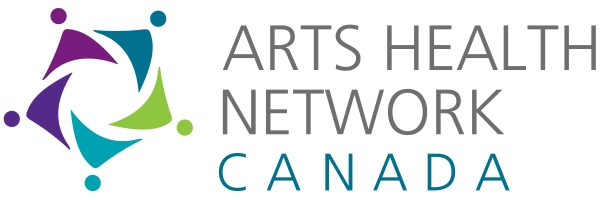By: Kira Tozer (@kiratozer) for Arts Health Network Canada (@artshealthca)

Kira Tozer
By: Kira Tozer (@kiratozer) for Arts Health Network Canada (@artshealthca)

Kira Tozer
Although I’ve been working with Arts Health Network Canada for a little over 2 years now, I must admit that I still struggle with my 10 second elevator pitch to describe what “Arts & Health” is all about. My short and scripted explanation is that “Arts & Health is a growing interdisciplinary movement that embraces many forms of art to promote health, prevent disease, and enrich research inquiry.” While true, it fails to capture the breadth of activities and transformative potential that exists at the intersection of the arts and health sectors.
If my elevator companion people seem intrigued (as they often are), I expand my elucidation and explain that Arts & Health is an umbrella term that includes pursuits: bringing visual arts, music, performances and art-making opportunities into health care environments; the creative arts therapies like music therapy, dance therapy, art therapy; community arts projects that address health or social problems faced by a group of people; arts-based health research; arts-based health communication; using the arts in the education of health care professionals, etc. Often I suggest checking out this infographic or this 15 minute mini-doc for a visual overview of Arts & Health.
The arts and health can intersect in many different ways, with different aims and outcomes. The arts can help us to understand, communicate and cope with various experiences of human illness – be it our own or a loved one’s, a patient’s or a provider’s. The arts help to reconnect us with the human element of health and health care.

Arts Health Network Canada
AHNC is a registered charity and virtual organization, functioning as a networking, capacity building and knowledge-sharing hub for anyone interested in the intersections between arts and health in Canada. We help to support connection, dialogue and information sharing, build networks and raise awareness of arts and health as well as share exemplary practices of arts and health in Canada and abroad.
As November is international Arts & Health Month it seems a fitting time to host a conversation in the Twitterverse on the value and growth of arts and health initiatives in Canada and abroad. Although there are many hot topics and areas buzzing with activity within the arts and health realm, we’ll focus on 3 areas for this chat: Arts-Based Health Communications, ‘Arts on Prescription’ and Health Humanities.
Arts-Based Health Communications
Health communications is “the study and use of communication strategies to inform and influence individual and communication decisions that enhance health”[i]. The arts can be a very effective means of boosting health communications, since, as many would agree, the arts can engage and communicate with us on many levels: emotional, sensory, aesthetic, cognitive, etc. As a knowledge translation vehicle, the arts – particularly film, theatre and research-based fiction – are gaining popularity in the health and social sectors to share new research findings. But how else can arts-based efforts contribute to health communications?
Arts on Prescription
From time to time I’m lucky enough to facilitate discussions about arts and health with groups including graduate students in public health, social work and gerontology, parks and recreation managers, arts administrators and occupational health and safety teams. I’ve noticed that discussions around art and health promotion inevitably land on social inclusion, and the fabulous opportunity that arts engagement creates for social connectivity and expanding social networks.
Related to this idea is a model making great strides in other parts of the world known as “Arts on Prescription” [ii][iii][iv] whereby primary care providers refer their patients to supportive community-based art groups. As explained by Arts & Health South West (UK), “Arts on Prescription is a type of Social Prescribing whereby health or social care practitioners refer people to a service or a source of support. The purpose of such schemes is not to replace conventional therapies but rather to act as an adjunct, helping people in their recovery through creativity and increasing social engagement. Although the schemes are varied in their approaches and settings, the common theme is that there is a referral process.” [v]
A Canadian example of a program like this is the Creative Works Studio in Toronto for people dealing with mental illness and/or addictions issues. There are a number of other art groups in communities across Canada that provide safe places for individuals experiencing a shared health problem to expand their social networks, cope, receive empathetic social support, foster resilience through creative expression, and develop new skills; however, most operate on self-referral basis.
What would be the challenges, implications and potential benefits of formalizing a referral process to programs like these programs by primary care providers?
Health Humanities
More and more post-secondary health faculties, including medical schools [vi], are adding arts and humanities components to their core and extra curriculums: book clubs, poetry at rounds, creative writing courses, art gallery ‘lab’ work, life drawing classes, illness-related dramatic performance, cinemeducation, narrative training, etc. These programs are introduced in efforts to foster compassion, empathy and resilience, hone observational skills and prevent burn-out in learners. However, some critics question the importance of such activities given the volume of science-based knowledge and procedural skills that students must master in such a compressed amount of time. What do you think? Should health humanities programs be championed and prioritized? Why?
Blue Sky Brainstorm
 We’ve come a long way in Canada over the last few years, with more and more Arts & Health programs and events and communities of practice surfacing in across the country. But what’s next? Where to from here? What do we need more of in Canada to grow connections, develop partnerships, build the business case for arts & health and gain more recognition from decision makers and funders?
We’ve come a long way in Canada over the last few years, with more and more Arts & Health programs and events and communities of practice surfacing in across the country. But what’s next? Where to from here? What do we need more of in Canada to grow connections, develop partnerships, build the business case for arts & health and gain more recognition from decision makers and funders?
Join us for the evening #hcsmca chat on Wednesday, November 25th at 6pm PT/9pm ET for a discussion on the arts, creativity, health and healing.
- T1. How can the arts enhance health communication and patient education? Share examples that include social media.
- T2. What is needed to introduce/expand the “Arts on Prescription” model in Canada?
- T3. Why is it important to include arts & humanities-based activities in medical/nursing/health curriculums?
- T4. What does Canada need more of to strengthen the ties between arts and health?
[i] Making Health Communication Programs Work. Bethesda, Md: National Cancer Institute; 2001
[ii] Bungay, H., & Clift, S. (2010). Arts on Prescription: A review of practice in the UK. Perspectives in Public Health, 130(6), 277–281. Retrieved from http://rsh.sagepub.com/content/130/6/277.short
[iii] Stickley, T., & Eades, M. (2013). Arts on prescription: a qualitative outcomes study. Public Health, 127(8), 727–34. Retrieved from http://www.publichealthjrnl.com/article/S0033-3506(13)00167-4/abstract
[iv]Stickley T, Hui A, Duncan K. Arts on Prescription Research Report. January 2011. Retrieved from: www.city-arts.org.uk/wp-content/uploads/2013/03/Arts-on-Perscription-Report.pdf
[v] Arts & Health SW. Arts on Prescription (Arts on Referral) Fact Sheet. Retrieved from: www.ahsw.org.uk/userfiles/files/AHSW_Arts_on_Prescription_Fact_Sheet.pdf
[vi] Zhang, Z. The Art of Healing. Havard Magazine – Humanities. July 2015. Retrieved from: http://harvardmagazine.com/2015/07/the-art-of-healing
Filed under: Guest moderator post, hcsmca, Social Media Tagged: arts, Arts Health Network Canada, Arts on Prescription, Kira Tozer
![]()







